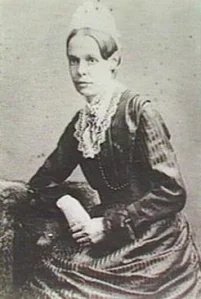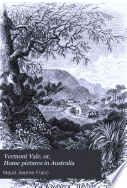by Anon
 The following, unattributed, review of Maud Jeanne Franc’s second novel, Vermont Vale: or Home Pictures in Australia appeared in the South Australian Register of Mon 17 Sep 1866. [Make sure you read the last sentence. I have no idea what it means. Bill]
The following, unattributed, review of Maud Jeanne Franc’s second novel, Vermont Vale: or Home Pictures in Australia appeared in the South Australian Register of Mon 17 Sep 1866. [Make sure you read the last sentence. I have no idea what it means. Bill]
LITERATURE.
VERMONT VALE; or HOME PlCTURES in AUSTRALIA.
By Maud Jeanne Franc, Author of “Marian; or the Light of Someone’s Home.”
Many of our readers will have a pleasant remembrance of ‘Marian,’ which is a sweet simple Australian tale. The success which that little work met with, and which was not more than it deserved, has induced the author again to venture before the public, whose suffrages she now seeks by “Vermont Vale”.
It is only fair to allow the author to state her object in the tale now before us. She says in the preface — “With the simple details of everyday life, at least in some of its phases, the author has endeavoured to blend a few of those clear Gospel truths that are able to make wise unto salvation with the blessing of the Holy Spirit upon them; and if, indeed, this blessing be bestowed — if only a few of those who have hitherto sought variety after happiness among earthly objects shall be led by the perusal of ‘Vermont Vale’ to discover the fountain from which true happiness alone can spring, most deeply grateful will be its author.”
 Now, no one has a right to complain if an excellent lady like the author chooses to make a tale the vehicle for conveying her religious notions, looking at it from an artistic point of view it may be a mistake, but she has a right to do so if she think fit. We are sorry to say that in working out her idea the writer has made her work rather heavy. There are several passages which even good people will feel inclined to ‘skip’ in order to get on with the fortunes of the character.
Now, no one has a right to complain if an excellent lady like the author chooses to make a tale the vehicle for conveying her religious notions, looking at it from an artistic point of view it may be a mistake, but she has a right to do so if she think fit. We are sorry to say that in working out her idea the writer has made her work rather heavy. There are several passages which even good people will feel inclined to ‘skip’ in order to get on with the fortunes of the character.When we take up a tale which professes to give home pictures of the land in which we live, we decidedly demur to being brought up short with pages of not very broad theology, and verses of hymns which do not always contain much poetry. We make these remarks at the very outset, that we may have done with the disagreeables.
With the single drawback to which we have referred, the little work is an interesting one, and contains pictures of Australian life which none but one who has lived in the country not far from Adelaide could have written. It is possible that “Vermont Vale” may be recognised both by the description which is given of it and by the exquisite frontispiece which, we believe, was drawn expressly for the work by Mr. G. Fetch Angas. The scene is altogether South Australian. Vermont Vale has its chapel, schoolhouse, and country store.
The story opens with an account of two young farmers living in bachelorhood at Sunny
Hollow — a rough but comfortable and roomy log house. Their sister, Katie Linwood, who is evidently intended to be the heroine of the book, comes to reside with her brothers and to keep house for them, their housekeeper and her husband having left them to go to the diggings.
Katie comes from a “professing” family, but she is a wild, mirthful, saucy young creature. Her eldest brother is a fine type of the better class of young farmers in the colony, thoughtful and industrious. The younger brother is too fond of gaiety and colonial wine, indulgence in which brings him to on early grave.
A certain Dr. Moore and his sprightly daughter, Fanny, occupy a rather important part of the tale. The doctor is rather hardly dealt with, because he has a dance at his house, and gives colonial wine to his guests, on which some of them get silly and quarrelsome, and Steven Linwood meets with an accident which brings on brain fever and almost kills him. This fact convinces Katie and her elder brother of the sinfulness of dancing and drinking colonial wine (we are afraid it was poor stuff), and lead them to mend their ways.
Then there is a young schoolmistress, drawn from life we should say, keeping her widowed and afflicted mother by the poor rewards of her irksome toil. Her character is well sketched. Then the last important personage in the book is the Rev. Graham Howard, the minister of the little chapel, who is rather an ordinary person.
There are some minor people who have not much to do with the story, the most notable of whom is the village storekeeper, who is thus sketched: —
Mrs. Bateman was short, round, and stout — not sleek — oh no! hers was hard solid fat; nothing unctuous or oily in its character. Many times have we heard and read the remark that fleshy people are always good-tempered. We beg to enter our protest against that statement. Many have we now in our mind’s eye fully entitled to the appellative stout or (permit it, gentle reader, for the term is more expressive) fleshy, but whose temper would not bear a breath — would not brook a contradiction.
We know at a glance our good-natured fat friend; there are soft dimples in her cheeks and chin — laughterloving, kind, gentle, tractable dimples; smiles are always lingering at the corners of her mouth; there is a deep, earnest, loving look in her eyes; she is one of those happy individuals whom a recent author has described as journeying through life on feather cushions… Mrs. Bateman, however, as we before hinted, was not of this downy, loving class; her fatness was firm, hard, and solid; there was nothing loving in her eyes, for they were grey, quick, and sharp. She had no other rapid movements, for she respected her own dignity too much for that, had not the ‘fat-solid’ interposed.
When she did go out, and she made it a rule to do so every Sunday to the little Vermont Chapel, it was edifying to see her as she marched along, slowly and solemnly, with stately steps, between her two daughters, Jeminy and Selina.”
This character is, we think, drawn from life, and it is well done. Mrs. Bateman was the village gossip, who did much mischief with her “unruly member.” We have also a good motherly body, overburdened with many children, and yet finding opportunities for doing good amongst her neighbours.
Fred Linwood admires the doctor’s daughter, but the warmest corner of his heart is reserved for the fair and good little schoolmistress. Linwood becomes ‘serious’, and marries the schoolmistress; Katie becomes ‘serious,’ and marries the parson, [who] then takes her to England to the great mourning and lamentation of Vermont Vale.
This is a very imperfect description of the story, but our readers should get the book and read it for themselves. Maud Jeanne Franc has considerable powers of description, a healthy tone of rural life, an observing eye, and a sweet feminine grace which steals into the heart.
There is a shade of sorrow over the work which may be but the reflection of the sadder side of the author’s own troubled experience, for she has known sorrow. If she had not preached quite so much her book would have been more interesting. But she has written with a purpose, and we can respect her evident desire to do good, even though the tale has somewhat suffered by it.
We believe she can write a better work than either of those she has given to the world, and the materials for such a book lie around her. We shall be glad to learn that she receives sufficient encouragement to induce her to come before us again. She should put a blacky [sic] or two in her next work, and describe them as they really are.
~
Maud Jeanne Franc
Vermont Vale: or Home Pictures in Australia
first pub. 1866
Vermont Vale: or Home Pictures in Australia
first pub. 1866
(available from Dymocks for $95, or free download from Archive.org)




